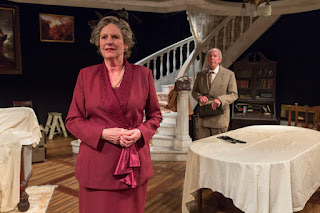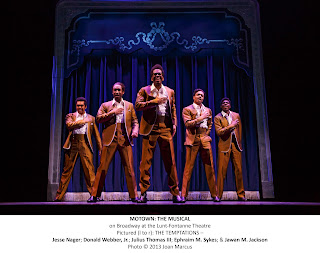I compiled this holiday gift list for Broadway Direct. Happy shopping!
Finding the right present for someone can be challenging, unless that someone is a theater-lover. From inexpensive stocking stuffers to memorable experiences, Broadway Direct’s holiday gift guide will steer you to a purchase that will truly be appreciated.
Books: The Drama Book Shop, 250 W. 40th St.
The hottest book this season is William Shakespeare’s Star Wars by Ian Doescher. Return once more to a galaxy far, far away with this retelling of George Lucas’s epic “Star Wars” in the style of The Bard. Reimagined in iambic pentameter — and complete with 20 Elizabethan illustrations, William Shakespeare’s Star Wars will astound and edify Rebels and Imperials alike. $15.95.
Also popular are:
To Be or Not To Be: A Chooseable Pub Adventure by Ryan North, William Shakespeare and YOU. A choose-your-own-path game book version of Hamlet. Play as Hamlet, Ophelia, or King Hamlet — if you want to die on the first page and play as a ghost. $28.95
Song of Spider-Man: The Inside Story of the Most Controversial Musical in Broadway History by Glen Berger. $25.
Untold Stories of Broadway Vol. 1: Tales from the World’s Most Famous Theaters by Jennifer Ashley Tepper. $19.99
www.dramabookshop.com; 212-944-0595
Theater-themed apparel and souvenirs: Theatre Circle, 268 W. 44th St.
The 6-foot-long woven and fringed piano keyboard scarf is double thick with piano keys image on both sides and has been a classic accessory. for decades $39.95
The Lion King musical snow globe features three-dimensional figures inside and surrounding the base. Plays “The Circle of Life” from the show. $29.95
The ticket/ticket stub organizer is a terrific way to preserve the ticket stubs one accumulates from going to Broadway shows and events. Holds up to 80 tickets (with place for notes) in 29 archival-quality, acid-free plastic pages. $15.99
oneshubertalley.com. To order these items, call 212-391-7075.
Posters: Triton Gallery, 630 Ninth Ave., has the world’s largest collection of theatrical posters.
This year's top-sellers are Pippin (2013 revival) Matilda and Kinky Boots. All $20
Display them in black, gold or silver metal frames with Lucite. $35 each.
www.broadwayposters.com; 212-765-2472
Tickets: If you want to send someone to the theater but don’t know what they’ll like, get a gift card from Telecharge. Cards start at $50 and are good for any show Telecharge represents, with no expiration date. Visit www.telecharge.com for a list of shows and to order. Gift cards also can be purchased at the show’s box office or by calling 212-239-6200/800-447-7400.
Theatrical experiences: Camp Broadway offers authentic Broadway experiences for young people:
Camp Broadway Dance: Dancers aged 14 to 18 learn how to apply classic dance technique to a real Broadway rehearsal room, immersing themselves in the dance style of a specific Broadway show or choreographer. Dancers develop their character through small group coaching and master classes that include all the skills needed to make it on the Great White Way: a mock audition, vocal rehearsals and ballet with a musical theater point of view. Feb. 15 to 17, $675 -- enroll before Dec. 31 to receive $50 off.
Camp Broadway enables theatre-loving children ages 10 to 17 to develop confidence, character and presentation skills through ensemble performance and an authentic Broadway rehearsal process. July 14 to 18, $1,295 -- enroll before Dec. 31 to receive $100 off.
Shining Stars encourages children ages 6 to 9 to discover their artistic voice through creative play. Over the course of the week, participants adapt and develop the script of a beloved and age-appropriate show. The group also workshops songs, creates unique choreography, paints sets and designs costumes for their final showcase on the Friday of their Camp week. July 14 to 18, $695 -- enroll by Dec. 31 to save $100.
The Next Step trains experienced performers ages 15 to 18 to improve their unique style and presentation skills through solo and small group acting, singing and dancing classes, all under the guidance of a mentoring coach. Participants have the opportunity to learn from Broadway professionals during master classes and individualized coaching sessions. The Next Step finale allows each participant to perform a solo piece as well as in ensemble numbers. July 14 to 18, $1,395 -- enroll by Dec. 31 to receive $100 off. For more information and to register, visit www.campbroadway.com
Theater tours: Broadway Up Close Walking Tours bring to life more than 100 years of ghost stories, anecdotes and other tales from behind the scenes in Broadway theaters. Normally $30 per person, a $5 discount will be given to anyone mentioning Life Upon the Sacred Stage. Offer expires March 1, 2014. Bookings may be made by e-mail -- info@broadwayupclose.com -- or phone -- 917-841-0187. For details, visit www.BroadwayUpClose.com.
The Gift of Song: THE SINGING EXPERIENCE, founded by award-winning director Linda Amiel Burns, offers nurturing, non-competitive and supportive workshops where you will conquer stage fright and learn to sing out with confidence and joy. The six sessions include four fun-filled rehearsals, a performance at The Triad where you and your classmates will be applauded by an audience of family and friends, and a Viewing Party to celebrate your success (a professionally taped DVD included in tuition). Special offer for Broadway Direct readers: $50 off of workshop tuition! See graduates in action at www.Youtube.com/SingingExperience or for more info: visit www.SingingExperience.com, Email: Linda@SingingExperience.com or phone 212 315-3500.
The Gift of Broadway: Audience Rewards ShowPoints can be redeemed for your choice of Broadway and Off-Broadway shows, theatre merchandise, unique experiences and more. Visit www.audiencerewards.com.
Dining: Sardi’s has gift certificates for any amount. Available at the restaurant, 234 W. 44th St., by phone -- 212-221-8440 -- or online -- www.sardis.com.
Collectibles: Broadway Cares/Equity Fights AIDS has a wide variety of theater-themed gifts, from a $5 red ribbon heart charm bracelet, to a set of six ornaments featuring Playbill covers for $50 and an apron and oven mitt set for $50. Children’s gifts, CDs, DVDs, T-shirts, jewelry and more are offered. Click on Shop for the Cause on www.broadwaycares.org.

























